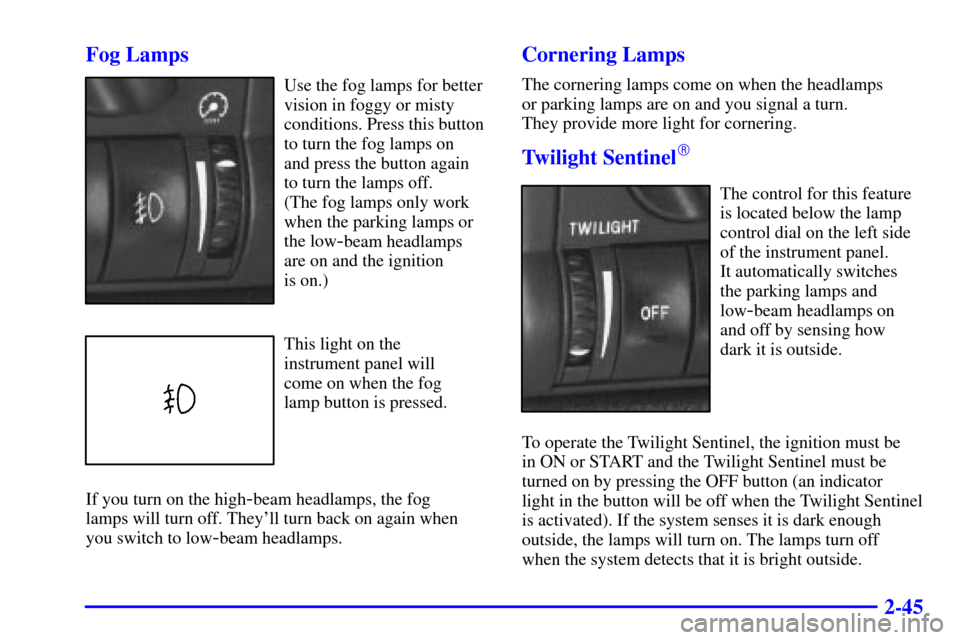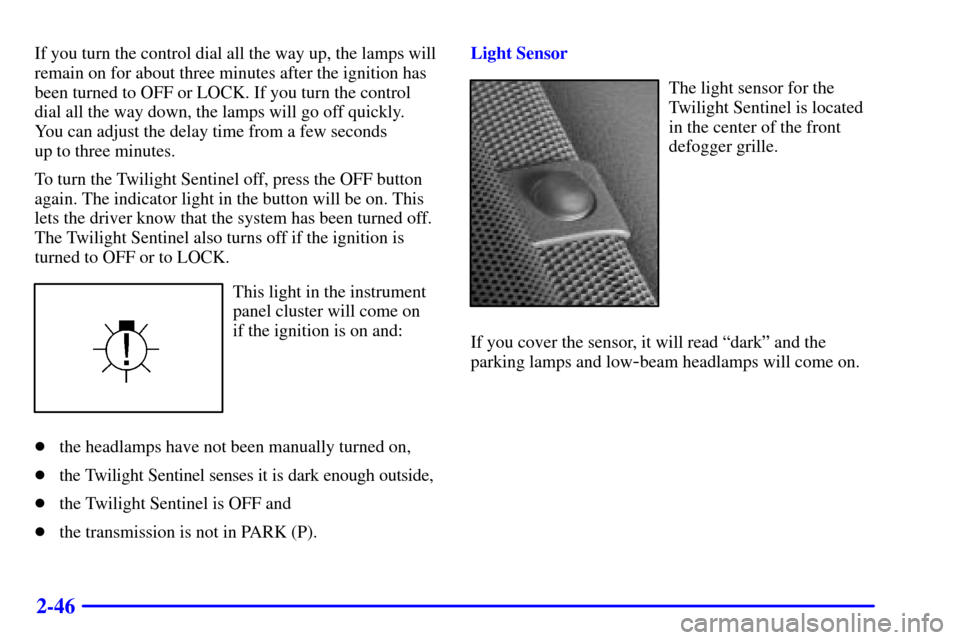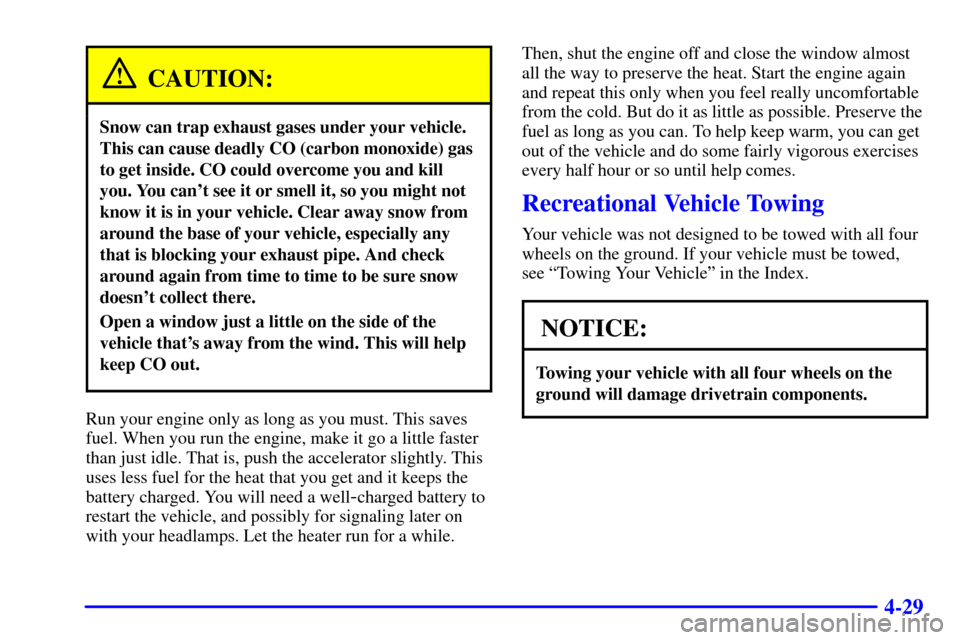Page 110 of 321

2-45 Fog Lamps
Use the fog lamps for better
vision in foggy or misty
conditions. Press this button
to turn the fog lamps on
and press the button again
to turn the lamps off.
(The fog lamps only work
when the parking lamps or
the low
-beam headlamps
are on and the ignition
is on.)
This light on the
instrument panel will
come on when the fog
lamp button is pressed.
If you turn on the high
-beam headlamps, the fog
lamps will turn off. They'll turn back on again when
you switch to low
-beam headlamps.
Cornering Lamps
The cornering lamps come on when the headlamps
or parking lamps are on and you signal a turn.
They provide more light for cornering.
Twilight Sentinel�
The control for this feature
is located below the lamp
control dial on the left side
of the instrument panel.
It automatically switches
the parking lamps and
low
-beam headlamps on
and off by sensing how
dark it is outside.
To operate the Twilight Sentinel, the ignition must be
in ON or START and the Twilight Sentinel must be
turned on by pressing the OFF button (an indicator
light in the button will be off when the Twilight Sentinel
is activated). If the system senses it is dark enough
outside, the lamps will turn on. The lamps turn off
when the system detects that it is bright outside.
Page 111 of 321

2-46
If you turn the control dial all the way up, the lamps will
remain on for about three minutes after the ignition has
been turned to OFF or LOCK. If you turn the control
dial all the way down, the lamps will go off quickly.
You can adjust the delay time from a few seconds
up to three minutes.
To turn the Twilight Sentinel off, press the OFF button
again. The indicator light in the button will be on. This
lets the driver know that the system has been turned off.
The Twilight Sentinel also turns off if the ignition is
turned to OFF or to LOCK.
This light in the instrument
panel cluster will come on
if the ignition is on and:
�the headlamps have not been manually turned on,
�the Twilight Sentinel senses it is dark enough outside,
�the Twilight Sentinel is OFF and
�the transmission is not in PARK (P).Light Sensor
The light sensor for the
Twilight Sentinel is located
in the center of the front
defogger grille.
If you cover the sensor, it will read ªdarkº and the
parking lamps and low
-beam headlamps will come on.
Page 113 of 321
2-48 Map Lamps
These lamps are located in the front overhead console
(near the windshield). Press either button to turn the
driver's or passenger's side lamp on and press the button
again to turn the lamp off.
These lamps also come on when any door is opened or
unlocked when it is dark outside.
Mirrors
Electrochromic Day/Night Rearview Mirror
This mirror automatically changes to reduce glare from
headlamps behind you. A photocell on the back of
the mirror senses when it is becoming dark outside.
Another photocell built into the mirror surface senses
when headlamps are behind you.
Page 133 of 321

2-68 Charging System Indicator Light
When you turn the key to
START, this light will come
on briefly to show that the
generator and battery
charging systems
are working.
If this light stays on, you need service and you should
take your vehicle to the dealer at once. To save the
battery until you get there, turn off all accessories.
Voltmeter
You can read battery
voltage on the voltmeter.
If it reads less than 12 volts
or more than 16 volts while
the engine is running, and it
stays there, you may have a
problem with the electrical
charging system.Have it checked right away. Driving with the voltmeter
reading in the lower warning zone could drain or
damage the battery. Driving with the voltmeter reading
in the upper warning zone could cause bulbs to burn out
(especially headlamp bulbs), various vehicle modules
to shut down (due to overload protection) and the
possibility of a battery acid leak.
If you idle the engine for a while, the voltmeter reading
might move into the red zone. If the reading stays in the
red zone while you are driving, you may have a problem
with the electrical charging system. Have it checked.
While the voltmeter reads in the red zone, the battery
may not be able to power certain electrical accessories,
like ABS. (If this happens, the ABS light will come on.
See ªAnti-Lock Brakes System Warning Lightº in
this section.)
If you must drive a short distance with the voltmeter
reading in a warning zone, turn off all the accessories,
including the comfort controls and the audio system.
Page 191 of 321
4-16
Driving at NightNight driving is more dangerous than day driving.
One reason is that some drivers are likely to be
impaired
-- by alcohol or drugs, with night vision
problems, or by fatigue.
Here are some tips on night driving.
�Drive defensively.
�Don't drink and drive.
�Since you can't see as well, you may need to
slow down and keep more space between you and
other vehicles.
�Slow down, especially on higher speed roads. Your
headlamps can light up only so much road ahead.
�In remote areas, watch for animals.
�If you're tired, pull off the road in a safe place
and rest.
Page 192 of 321

4-17
No one can see as well at night as in the daytime. But as
we get older these differences increase. A 50
-year-old
driver may require at least twice as much light to see the
same thing at night as a 20
-year-old.
What you do in the daytime can also affect your night
vision. For example, if you spend the day in bright
sunshine you are wise to wear sunglasses. Your eyes
will have less trouble adjusting to night. But if you're
driving, don't wear sunglasses at night. They may cut
down on glare from headlamps, but they also make a lot
of things invisible.
You can be temporarily blinded by approaching
headlamps. It can take a second or two, or even
several seconds, for your eyes to readjust to the dark.
When you are faced with severe glare (as from a driver
who doesn't lower the high beams, or a vehicle with
misaimed headlamps), slow down a little. Avoid staring
directly into the approaching headlamps.Keep your windshield and all the glass on your vehicle
clean
-- inside and out. Glare at night is made much
worse by dirt on the glass. Even the inside of the glass
can build up a film caused by dust. Dirty glass makes
lights dazzle and flash more than clean glass would,
making the pupils of your eyes contract repeatedly.
Remember that your headlamps light up far less of a
roadway when you are in a turn or curve. Keep your
eyes moving; that way, it's easier to pick out dimly
lighted objects. Just as your headlamps should be
checked regularly for proper aim, so should your eyes
be examined regularly. Some drivers suffer from night
blindness
-- the inability to see in dim light -- and
aren't even aware of it.
Page 204 of 321

4-29
CAUTION:
Snow can trap exhaust gases under your vehicle.
This can cause deadly CO (carbon monoxide) gas
to get inside. CO could overcome you and kill
you. You can't see it or smell it, so you might not
know it is in your vehicle. Clear away snow from
around the base of your vehicle, especially any
that is blocking your exhaust pipe. And check
around again from time to time to be sure snow
doesn't collect there.
Open a window just a little on the side of the
vehicle that's away from the wind. This will help
keep CO out.
Run your engine only as long as you must. This saves
fuel. When you run the engine, make it go a little faster
than just idle. That is, push the accelerator slightly. This
uses less fuel for the heat that you get and it keeps the
battery charged. You will need a well
-charged battery to
restart the vehicle, and possibly for signaling later on
with your headlamps. Let the heater run for a while.Then, shut the engine off and close the window almost
all the way to preserve the heat. Start the engine again
and repeat this only when you feel really uncomfortable
from the cold. But do it as little as possible. Preserve the
fuel as long as you can. To help keep warm, you can get
out of the vehicle and do some fairly vigorous exercises
every half hour or so until help comes.
Recreational Vehicle Towing
Your vehicle was not designed to be towed with all four
wheels on the ground. If your vehicle must be towed,
see ªTowing Your Vehicleº in the Index.
NOTICE:
Towing your vehicle with all four wheels on the
ground will damage drivetrain components.
Page 259 of 321

6-15
If none of them is true, use the long trip/highway
maintenance schedule. Change the oil and filter at the first
5,000 miles (8 000 km) or 3 months
-- whichever occurs
first. Then, change the oil and filter every 10,000 miles
(16 000 km) or 12 months
-- whichever occurs first.
Driving a vehicle with a fully warmed engine under
highway conditions causes engine oil to break
down slower.
What to Do with Used Oil
Did you know that used engine oil contains certain
elements that may be unhealthy for your skin and could
even cause cancer? Don't let used oil stay on your skin
for very long. Clean your skin and nails with soap and
water, or a good hand cleaner. Wash or properly throw
away clothing or rags containing used engine oil.
(See the manufacturer's warnings about the use and
disposal of oil products.)
Used oil can be a real threat to the environment. If you
change your own oil, be sure to drain all free
-flowing
oil from the filter before disposal. Don't ever dispose of
oil by putting it in the trash, pouring it on the ground,
into sewers, or into streams or bodies of water. Instead,
recycle it by taking it to a place that collects used oil.
If you have a problem properly disposing of your used
oil, ask your dealer, a service station or a local recycling
center for help.
Engine Air Cleaner/Filter
The air cleaner is located behind the headlamps on
the passenger's side of the engine. Be sure the engine
has cooled before following these steps to replace the
air filter.